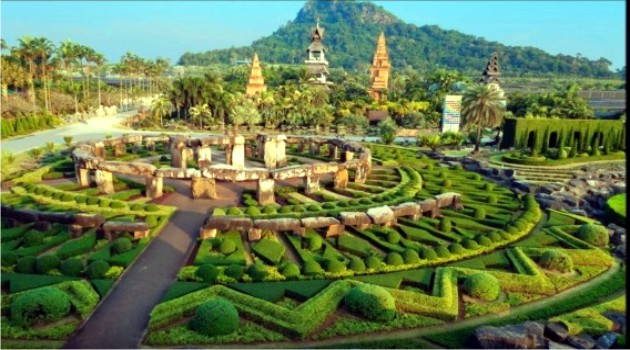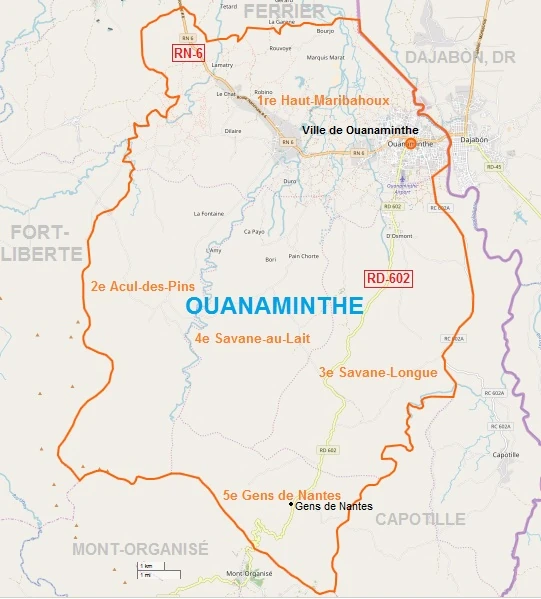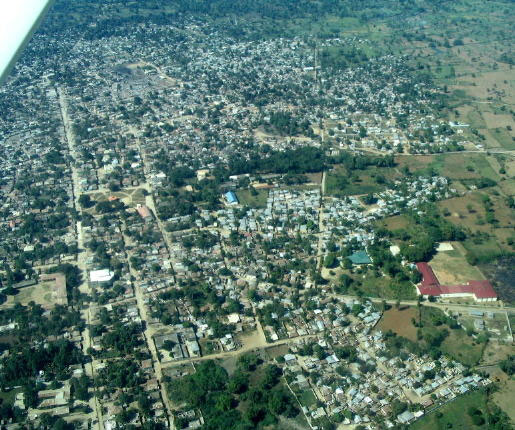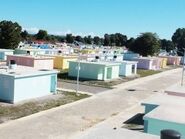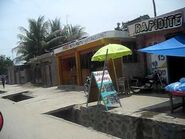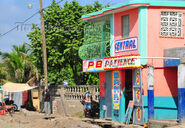"Tout moun se moun, tout moun pa menm."
All people are people but not all people are the same.
-Haitian proverb

Welcome sign

Seal of the City of Ouanaminthe. "Labor et dignitas semper"
(Always worth the effort)


Welcome
Ouanaminthe (Kreyòl: Wanament, Spanish: Juana Mendez) is a city and the seat of Ouanaminthe Arrondissement in the Northeast Department of Haiti. Situated in the far northeastern corner of the country, it is home to about 100,000 people.
Ouanaminthe stands on the Dajabón River across the Dominican Republic-Haiti border from Dajabòn, the most populous city in the Dominican province of of the same name. Ouanaminthe is 22km south of the the Northeast Department capital city of Fort-Liberté. The two cities, along with Cap-Haïtien in the neighboring Northern department, form a combined international metropolitan area sometimes referred to as the Couloir Nord-Est or the Northeast Corridor. The region of over 750,000 people constitutes the largest bilingual and binational work force in Hispaniola.
The city is the operations base of several textile industries, an industry which represents Haiti's manufacturing sector, accounting for 90% of the country's exports and about 10% of the country's gross domestic product, as well as home to the Univers Medical Center, the only medical research and care provider complex in Ouanaminthe, and a public law school, the city's primary university. The city hosts several annual festivals and is home to the Ouanaminthe Football Club.
Within it lays the Massacre River or Dajabon River which provides a border between the Dominican Republic and Haiti. The river is named for an incident that took place in 1728 in which 30 French Buccaneers were massacred by Spanish settlers.
Ouanaminthe has become one of the major urban centers of the Northeast, mainly because of its proximity to the Haitian-Dominican border which makes it the seat of a regular and intense cross-border trade. Also, it attracts many people from other regions of the country. The city is the busiest international crossing point in Haiti.
About[]
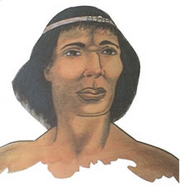
Guarionex, chief of the ancient Taino kingdom of Maguá and son of chief Guacanagaríx, the great Taíno prophet who had the vision of the coming of the Guamikena (White Men).
Ouanaminthe, in particular its urban part, represents the most important urban center located on the Haiti-DR border line. In general, the city is now recognized as being the most important economic center in all the Northeast department. The commune of Ouanaminthe is also the birthplace of Joseph Courtois, Davilmar Théodore (former President of the Senate and of the Republic), Queen Marie-Louise Christophe - born Marie Louise Coïdavid (wife of King Henry I), and René Théodor (politician). The city celebrates its patronal feast on August 15 in honor of Our Lady of the Assumption. Locally, the name Ouanaminthe is often abbreviated to Ouathe.
Etymolygy[]

Buenaventura Báez (In full: Ramón Buenaventura Báez Méndez); the 3rd, 6th, 10th, 13th, and 16th President of DR, and the son of Juana Méndez
The area of Ouanaminthe was first called Guanaminto by the Taíno tribe, who lived there for at least two thousand years prior to European colonization in the 1400s. During spanish colonization, its was renamed Juana Méndez, after a black ex-slave, wife of the merchant Pablo Báez (who was mayor of Azua de Compostela) and mother of Buenaventura Báez, the first mulatto president of the Dominican Republic. Following linguistic distortions by the French settlers who had come to settle in the town, it was given its current name, Ouanaminthe.
History[]
A Native American village existed on the site of the area now known as Ouanaminthe, prior to the arrival of Christopher Colombus towards the end of the 15th century (1400's). The town was inhabited by the Spaniards during the colonial era, but the old town was formally traced in 1731 by the French as a military outpost and trading post with the Spaniards. It was granted municipal status in 1807, after the National Independence of 1804. It has had various names throughout its history, including Ouanaminto (a canton of the Arawak Kingdom of Maguá), and Juana Méndez (its name during Spanish occupation).
The commune had an active part in the fight against the oppressive colonial system, with the presence of many men of color in the said commune who attended the French Revolution. Moreover, during the period of King Christophe, from 1807, Ouanaminthe experienced an astonishing prosperity which made it the granary of the Northeast Department. It also constituted an important source of supply for the inhabitants of Cibao. However, the commune experienced regrettable events, which later ruined it.
In 1855, soldiers from the government of Faustin I, opposed by the local militia, sowed mourning in several Ouanaminthaise families. Later in 1911, President Antoine Simon, who had not succeeded in rallying the population to his cause, had the city set on fire, along with several plantations. The history of the city of Ouanaminthe is also marked by the rebellion against the American occupation during the battle of Juaria in 1915. The Cacos revolutionaries forced the men in the service of the occupier to take refuge in Dajabón where they obtained aid from the Dominicans and returned to the assault to demolish the historic fort of Ouanaminthe.
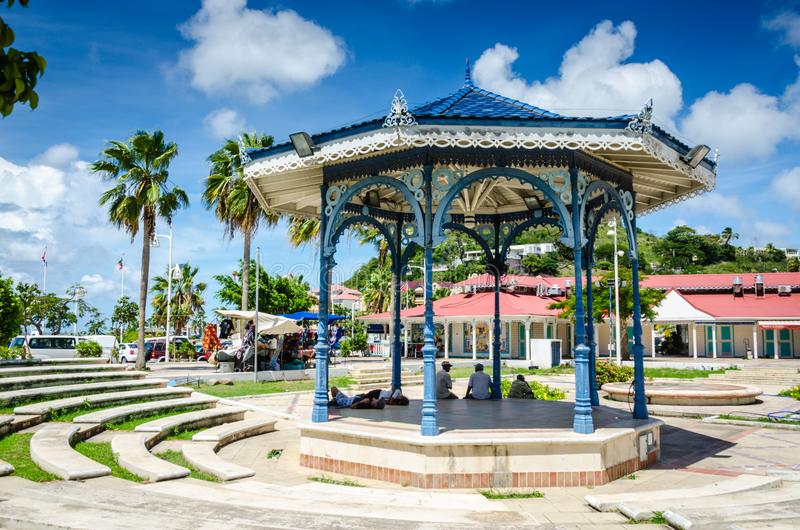
Ouanaminthe Plaza, Nord-Est, Haiti
Geography[]
Ouanaminthe is located at 18.5128° N, 72.6240° W, on the DR border. According to the IHSI, this commune has a total land area of 199.06 square kilometers (76.86 square miles), of which 146.40 km² (74%) is rural, 49.52 km² (24%) is suburban, and 3.14 km² (2%) is urban. Ouanaminthe is an inland city situated on the Dajabón River. It is bordered on the north by the town of Ferrier, on the east by the Dominican city of Dajabón and the town of Capotille, on the south by the town of Mont-Organisé, and on the west by the city of Fort-Liberté. Ouanaminthe has a district, along with 5 communal sections spread across a landscape that primarily consists of plains. Additionally, it has about 14 localities and 93 habitations. It enjoys a tropical climate where it is mostly hot, because of its geographical position.
The law of November 20, 1821 fixes the legal distance of this common to the capital at 75 leagues. Its mountains contain iron and sulfur mines. A gold mine was exploited by the Spaniards in the nearby rural section of Lamine.
Neighborhoods
| OUA | Ouanaminthe | 106,129 | ||||
|---|---|---|---|---|---|---|
| VOU | Ville de Ouanaminthe | Urban | 70,905 | |||
| HMB | 1ère Section Haut-Marihaboux | Rural section | 13,370 | Bourjo, Coujol, Dilaire, Duro, Gaïac, Gounote, Grande Savane, Lamatry, Le Chat, Maboule, Marquis, Marquyis Marat, Melchoir, Papa Jacques, Passa Café, Pérard, Pirobert, Place Pre d'Homme, Robino, Rouvoyé, Scott, Sens, Sorselle, Ti laurier. | ||
| API | 2ème Section Acul-Des-Pins | Rural | 4,827 | Disara, Duvigal, Francisque, Gullouette, Jourdain, L'Acul des Pins, La Fleur, La Fontaine, Lorier, Mont Premier, Pierrot, Poirier, Vieux Caille | ||
| SAL | 3ème Section Savane-Longue | Rural | 9,563 | Baja, Baptiste, Bedou, Beneste, Bois Gens, Boujo, Chancerelles, Dominique, Joulin, Jourdain, La Garenne, Marie Borbin, Marionette, Réforme, Savane au Lait, Savane Dosmont, Savane Longue, Vano | ||
| SLA | 4ème Section Savane-au-Lait | Rural | 4,252 | Ali, Blond, Bori, Bosse, Ca Poyo, Dépé, Diasa, L'Amy, Larode, Savane Au Lait, Templier | ||
| GNT | 5ème Section Gens-de-Nantes | Rural | 3,212 | Baptiste, Chutte, En bas Boisson, Gens de Nantes, Jean Rabel, Matayer, Pacot, Ti Mélia. |
Demographics[]
Its inhabitants call themselves Ouanaminthais, Ouanaminthaises. In 2015, the gender ratio was estimated at 92 men per 100 women. More than 55% of the municipality's population resided in urban areas. The distribution of the municipality's population by major age group is as follows:
42% of its population is under 15 years old
54% of its population is aged 15-64
4% of its population is aged 65 and over.
| Year | Population | |
|---|---|---|
| 1890 | 10,000 | |
| 1998 | 53,696 | +437% |
| 2003 | 77,319 | +44% |
| 2009 | 96,515 | +25% |
| 2012 | 101,260 | +5% |
| 2015 | 106,129 | +5% |
Climate[]
From the agro-ecological point of view, the commune of Ouanaminthe is located in the wetlands, with an average rainfall of 1800 mm (71 inches). Its average temperature is 27°C (81°F) and its wettest months are from July to December.
Natural resources
In valleys such as Savane-au-Lait and Savane Long, the grounds are soils from the decomposition of quartziferous diorites which give them a clear hue and sandy texture. On the other hand, in mountain areas like Gens-de-Nantes, soils are of volcanic origin, usually shallow but still productive. In the plain of Maribaroux, they are colluvial, with a frank texture and good agricultural potential.
Enviornment[]
Uncontrolled exploitation of quarries and mines
The sand quarries of the Massacre, Lamatrie, Jassa and Canari Rivers are very poorly exploited. Among other consequences on the environment, the destabilization of the banks. Scouring is carried out often too close bridges and is detrimental to these works, as it weakens the deck. Moreover, it often causes puddles of stagnant water that promote the hatching of insects and release at times an unpleasant odor.
Although mining is uncommon in the city of Ouanaminthe, a survey reported mining activity at Acul des Pins, in the year 1990, at the level of gold mines. The impact of this operation on the environment is marked by noticeable unseen cuts that disfigure the landscape.
Lagoons and recreation sites
In the commune of Ouanaminthe, many natural sites and lagoons have been spotted such as the Acul-des-Pins waterfalls, the five Haut-Maribaroux lagoons, and the one of Savane-Longue (Fagale Lagoon). They shelter many animal species and innumerable plants, many of which have not yet been identified. They are not managed despite their potential for aquaculture development, ecotourism and the conservation of biological diversity.
Population explosion and anarchic urbanization
Ouanaminthe, border town, is the seat of intense two-weekly trade exchanges (Monday and Friday, market days of the twin city of Dajabon) that attract a lot of visitors. This The influx of temporary visitors creates enormous pressure on the resources of the area. A lot of them decide to stay permanently in the area, increasing the population and, as a result, demand goods and services on the same area. Along the streets too narrow and deteriorated, these newcomers are brought in to build houses of fortune for their lodgings. These houses are often erected apart from the most basic building standards.
Economy[]

Unibank Ounaminthe
Ouanaminthe has a diversified economy focused primarily within two pillars: international trade and services. These sectors are mainly dominated by trade in goods and services with the Dominican Republic, which is particularly active on Mondays and Fridays, the market days in the city of Dajabón. The result is an ever-increasing flow of merchandise and merchants from neighboring areas or other departments of the country. This influx of temporary visitors creates an additional pressure on the meager services and amenities of the city. Data provided by the customs director of Ouanaminthe show the importance of trade in the area. They inform that on average, more than 40,000 bags of cement, 1,000 tons of iron, and two to three containers of spaghetti leave the neighboring peninsula every month and pass through Ouanaminthe. Other materials (plumbing for example), are evaluated to a container every four months. Products supplying the informal sector (paper plates, vegetables and fruits, cereals, bananas, citrus fruits, etc.) are intensively transported at the rate of fifteen to twenty trucks per month. In addition, five shops and warehouses, owned by Dominicans, are already installed in the center of the city. The services offered are as numerous as they are diverse and are dispensed in hairdressing salons, a beauty studio, hotels and motels, restaurants, laundries, and other small businesses, which tend to multiply.
For economic and financial infrastructures, the commune of Ouanaminthe has 18 hotels, four commercial banks, three credit unions, and three marketing cooperative centers. There are more than 130 borlette banks (including gatehouses) and 25 business houses.
The commercial and economic establishments of the municipality range from construction materials companies and dozens of food supply centers to pharmacies and photocopy shops. Also, other small informal activities located everywhere, especially near the border, include the public market and the roadside where the merchants of food, the polishers of shoes, forex dealers, and taxi-motorcycle drivers (estimated at more than 600) evolve.
The industrial sector is also present with two ice plants and drinking water production plants, processing units (corn mills, peanut mills, rice mills, bakeries (over twenty), and a dry cleaning company. In August 2003, a free zone was set up near the border, where the trousers factory operates Levi's. This company employs 550 employees at a rate of 432 gourdes for a 48-hour week. The production has already reached about 20,000 jeans, although the factory operates only at less than 5% of its capacity. It plans to increase its staff to 10,000 men / day and diversify its products.
One of the major handicaps of the industrial sector remains the adaptation to the proposed technology, and especially acceptance by the population of the new assignment of this part of the plain because the plant was erected in an area with high agricultural potential. Nevertheless, its installation may appear also as a development to the region.
Agriculture
In addition to trade and services, beekeeping helps to support farmers in Ouanaminthe, as well as agriculture with groundnuts and maize as main crops.
Although the production of honey has decreased a lot in the commune, it is much ahead of Ferrier and Fort-Liberté. Beekeepers report that Ouanaminthe once exported honey to France, the United States and Germany, at the initiative of the Oblate Fathers who supported this activity. Unfortunately, the beekeepers could not meet the required quotas or maintain the quality label required by local exporters.
Peanut production is concentrated mainly in the communal sections of Savane Long, Savanne-au-Lait, and neighboring Capotille.
The cultivation of corn is also a source of income for the planters of the communal sections of Ouanaminthe. But the installation of the free zone has considerably reduced the space occupied by this activity. Nevertheless, the development possibilities of the Maribaroux plain still exist despite the free zone, as it is still possible to irrigate it from several outlets on the Massacre river.
Beekeeping is classified as an income-generating activity for the inhabitants of the Northeast and those of Ouanaminthe in particular. The current production of honey is far from satisfying the demands of the community and surrounding areas. It is estimated at around 8,000 gallons (@ 400 gourdes / gallon), against 16,200 gallons previously harvested (CAO, 2004). To this must be added the market value of the by-products such as wax (@ 25 gourdes / lb) and propolis (@ 500 gourdes / lb).
A major cause of decline in bee production is the cutting down of honey-bearing trees, such as logwood, mango, and avocado, for the production of coal, the primary source of energy of current use.
Infrastructure[]

Ouanaminthe - Dajabón border crossing. The two are separated by the Dajabón River.
Transportation
The road network is at basic condition, not the subject of any sustainable intervention. The internal roads are impassable and, as a result, the production areas remain difficult to access. Routing drugs, school supplies, and agricultural products becomes problematic, as well as access to goods and services. The dirt roads connecting Ouanaminthe to the communal sections are drivable only by dry weather, which contributes to the isolation of production areas and recreation sites.
Pathways are necessary for the transport of patients, patients in labor, casualties, medicines, school materials, materials, and food products. Well built and well maintained, they provide multiple benefits such as, accessibility to production areas, good circulation of information, cultural and commercial exchanges, and lowering the cost of transport. Rehabilitation of road sections Haut Dilaire - Lamatrie National School (10 km), Dilaire - Robineau (8 km), Carrefour Lemercier - Acul-des-Pins (14 km), and Carrefour Contoir - Rivière Gens-de-Nantes / Dosmond - Marinette (14km) were at the forefront. With its poorly drawn streets and dilapidated buildings and rudimentary, Ouanaminthe offers the unsightly appearance of a large slum.
Education

Ouanaminthe children
As the administrative center of the district, Ouanaminthe enjoys about ten kindergartens, more than 130 primary schools, about thirty secondary schools, two technical and vocational schools, and a law school. The education department is represented there by a school inspection office. One of biggest issues remains the teacher/student ratio, which is 1:45 in the secondary schools and 1:50 in the primary schools, which has implications for the quality of the educational services offered.
Health
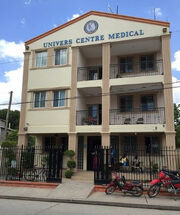
Univers Medical Center
Ouanaminthe is the medical hub of Northeastern Haiti, hosting numerous private clinics belonging to Haitian or Dominican practitioners whose outpatient doctors provide oral care to patients from the region. The city's top hospital is a medical center with beds, similar to a hospital: the CMSO (Medico-Social Center of Ouanaminthe). Pre and postnatal care are provided with family planning and epidemiological surveillance. The service hospitalization of the CMSO concerns the main sections: Pediatrics, Internal Medicine, Maternity and surgery. Univers Medical Center is the only trauma center in the region. The health department is not represented in the city of Ouanaminthe. A sizeable team of doctors, nurses, auxiliaries, certified matrons and two laboratory technicians train the technical staff of the three health establishments inventoried in the commune.
Utilities
In terms of water availability, the town has eight rivers, a lagoon and public fountains with nearly two dozen pumps. The drinking water supply system in the city is failing. It does not serve the majority, often only a tiny portion of the population. A large fraction consumes well water and rivers of dubious quality, which causes enormous damage to health.
In Savane Long, Gens-de-Nantes and Savane-au-Lait, there are some hand pumps. But they are insufficient in relation to the rate of growth of the population, and to gain access, it is often necessary to travel dozens of kilometers.
The accelerated growth of the city of Ouanaminthe creates a strong pressure on the water resource. The demand for drinking water exceeds the capacity of existing systems, which are polluted by all kinds. Drainage system and tailings management is another area that demands attention.

Goats graze in front of the Haitian National Police station in Ouanaminthe, Haiti
Security
Concerning the administrative and judicial infrastructures, the commune has a police station, a court of peace and a registry office.
The garrison of the commune consists of the 26th line infantry regiment created on October 16, 1866, a line artillery company from Fort-Liberté, an administrative police company, the national guard on foot and on horseback, and the rural police.
Administration
With regard to administrative and judicial infrastructure, the municipality has a peace court, a police station, a tax office, and an civil status office. There is also a prison.
As of December 2021

City Hall
 Demetrius LUMA |
 Clertilia Pierre-Antoine |
 Amos Jospeh |
| Political Party: PHTK
|
Culture[]
Communication
The town has a telephone office, a postal office and two radio stations. It has no newspaper / magazine nor television station.
The post arrives in Ouanaminthe by way of Le Cap on Monday evening and leaves on Tuesday morning. In his government program, General Legitime proposed the creation of a railway line from Cap-Haïtien to Ouanaminthe via Perches. The proposed administration of this commune was suppressed on December 11, 1822 with those of the other communes of the interior.
Religion

Notre Dame Church of Ouanaminthe
Ninety-nine churches and temples have been listed in the commune. The Baptist churches are the most numerous, 67 in total.
The Orient Lodge of Ouanaminthe, belonging to the Grand Orient of Haiti, is called Union des Frères.
Organizations
The municipality of Ouanaminthe is distinguished by a rather active associative life. Its characteristic as a border town, and the accompamying cross-border traffic, the establishment of the free zone and CODEVI factory, and city plan of 2010 are factors that promote organizational dynamics in the municipality.
In 2013, a non-exhaustive census gave nearly 200 civil society organizations (CSO) and grassroots community organizations (OCB) of various types in the commune. These CSOs/CBOs intervene in various sectors ranging from the defense and protection of the rights of Haitian migrants, through the development or strengthening of relations between Haiti (Ouanaminthe) and the Dominican Republic (Dajabón) to socio-economic development of the communities thanks in particular to the implementation of the Community and Participatory Development Project (PRODEP) implemented by CECI (Canadian Center for International Cooperation) in the municipality.
There are some local NGOs (Ouanaminthe Belle, Ouanaminthe Propre, CLES, Border Solidarity, Plan Haiti, and Hope for Haiti) who work in the social development sectors of the municipality. Some of these so-called local NGOs implement important projects in the community. Other national NGOs and international organizations are also involved. Their fields of activity are diverse; Plan Haiti intervenes in the field of education, agriculture and health. Its development programs are marked by intensive training. The actions of Border Solidarity are moving towards human rights, gender issues and social advancement.
These committees are made up of professional (men and women) residents of the municipality who want to provide technical input to the development of their community. Additionally, the commune contains seven popular organizations, seven peasants groups, and a non-commercial cooperative center. Several deconcentrated institutions of the state apparatus (Departments of health, agriculture, energy, and public safety) to name a few, operate in Ouanaminthe, with, for the most part, meager financial and logistical assistance, which significantly reduces the scope of their actions and the quality of services offered to the community.
Leisure

Ounaminthe public place
As leisure, the town has a library, but it has no museum, no theater nor cinema. The sports practiced are football (soccer) and basketball. For the monuments and sites, it contains three. These are natural sites located mainly in the communal sections. Every 15th of August, the commune of Ouanaminthe celebrates its patron saint Notre Dame de l'Assomption in a solemn way.
For the inhabitants of Ouanaminthe, Jassa Falls a very popular recreation center, particularly during the summer holidays. There is great recreational potential for the city's other water points, including its five lagoons. In addition to relaxation, their exploitation for aquacultural purposes would be beneficial to people who find animal proteins and raw materials for the craft industry.
Urban Issues[]
A problematic analysis for the environment and development of the commune of Ouanaminthe reveal that the environmental problems of Ouanaminthe are very complex. Next to those facing the entire department, Ouanaminthe undergoes very specific constraints related to the behavior of its population and the inability of local authorities to manage the environment. The work leading up to the present diagnosis made it possible to classify them as follows: Destruction of honey plants, Floods caused by the overflowing of the Massacre, Lamatri and Petite Rivière rivers, accumulation of waste, obstructing drainage canals and unsanitary streets, population explosion and anarchic urbanization, water pollution, Lack of management of lagoons and recreation sites, anarchic exploitation of quarries, and bad state of the local roads.
References[]
Plan de Financement des Services communaux de Ouanaminthe - Mairie de Ouanaminthe - [1]
Inventaire des ressources minieres de la republique du Haiti - Bureau des mines et d'energie - [2]
Information-Figi Laria Janl Yea-Vil Wanament Nord-est Haïti - Gadesa TV - [3]
Juana Mendez - Wikipedia - [4]
Une audience publique sur le budget communal de Ouanaminthe prévue pour le 26 janvier - par Jéthro-Claudel Pierre Jeanty - Nord Est info - [5] Michael Vedrine
